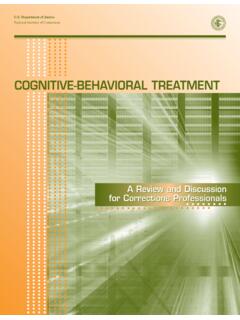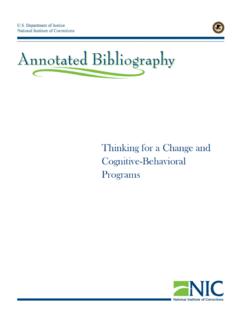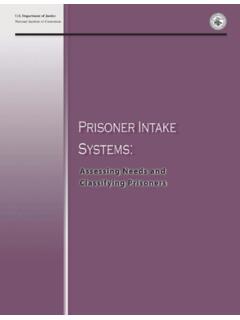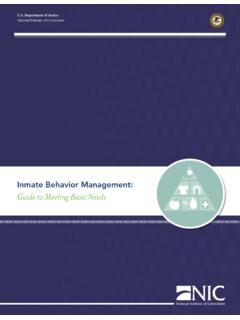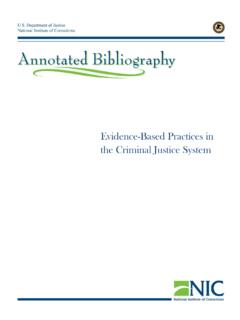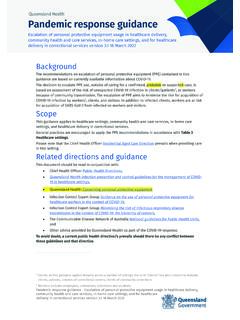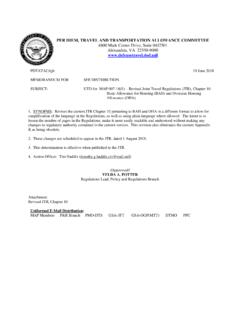Transcription of PRISON STAFFING ANALYSIS
1 Department of Justice National Institute of Corrections PRISON STAFFING ANALYSIS A TRAINING MANUAL With STAFFING Considerations for Special Populations Department of Justice National Institute of Corrections 320 First Street, NW Washington, DC 20534 Morris L. Thigpen Director Thomas J. Beauclair Deputy Director BeLinda P. Watson Chief, Prisons Division National Institute of Corrections PRISON STAFFING ANALYSIS A TRAINING MANUAL With STAFFING Considerations for Special Populations CAMILLE GRAHAM CAMP WITH CONTRIBUTIONS FROM PATRICIA L. HARDYMAN ROBERT MAY GEORGE M. CAMP DECEMBER 2008 NIC Accession Number 022667 This document was prepared under cooperative agreement number 03P25 GIY5 from the National Institute of Corrections, Department of Justice. Points of view or opinions stated in this document are those of the authors and do not necessarily represent the official position or policies of the Department of Justice.
2 CONTENTS Foreword .. vii Preface ..ix Acknowledgments .. xiii Introduction: correctional STAFFING Issues .. xv Part 1. Laying the Foundation Chapter 1. Security Staff Deployment Policy .. 3 Chapter 2. Two Models for Managing the Security STAFFING Function .. 7 Chapter 3. Agency STAFFING Unit .. 11 Chapter 4. Basic Tasks of a STAFFING ANALYSIS .. 17 Chapter 5. Orchestrating the STAFFING ANALYSIS .. 21 Part 2. Conducting the Staffi ng ANALYSIS Chapter 6. Agency and Facility Characteristics That Infl uence STAFFING .. 29 Chapter 7. Operations and Activities Schedules That Infl uence STAFFING .. 35 Chapter 8. Developing the Shift Relief Factor .. 39 Chapter 9. Security Post Planning .. 49 Chapter 10. Special Guidelines for Evaluating Housing Units .. 67 Chapter 11. The Impact of Staff Scheduling on STAFFING .
3 85 Chapter 12. STAFFING Calculations .. 91 Chapter 13. Developing a STAFFING Report .. 95 Chapter 14. Implementing Recommendations and Monitoring Results .. 103 Part 3. Special Guidelines and Considerations Chapter 15. STAFFING Considerations for Women s correctional Facilities .. 109 Chapter 16. STAFFING Considerations for Medical and Mental Health Units .. 121 | iii CONTENTS Glossary .. 131 Bibliography .. 143 Appendixes Appendix A. Security STAFFING for Prisons: Results of Four Nationwide Inventories .. 151 Appendix B. Blank Forms Appendix C. Sample Description of a Department of Corrections .. 207 and Its Facilities .. 223 List of Exhibits Exhibit 1. Sample Assignment and Scheduling Procedure: Daily Roster .. 5 Exhibit 5. Example of Form B: Shift Relief Factor Based on Exhibit 7. Example of Form D: Post Evaluation and Planning Instrument, Exhibit 8.
4 Example of Form D: Post Evaluation and Planning Instrument, Exhibit 10. Schematic Design of Two Adjacent Units Joined by a Exhibit 11. Schematic Design of Four Units Surrounding a Foyer Exhibit 13. Example of Form F: Total Staff Required and Exhibit 14. Views on the Medical and Mental Health Needs of Female Inmates and the Effect of These Needs on Exhibit 15. Views on the Needs of Pregnant Inmates and the Exhibit 2. Model Agency STAFFING Function .. 8 Exhibit 3. STAFFING ANALYSIS Process .. 18 Exhibit 4. Example of Form A: Daily Activities for Facility .. 37 Net Annual Work Hours .. 44 Exhibit 6. Example of Form C: Shift Relief Factor Based on Days .. 47 Part 1, Current Post Plan .. 54 Part 2, Recommended Post Plan .. 55 Exhibit 9. Examples of Form E: Recommended Post Modification .. 56 Control Room and Hallway.
5 78 With a Central Control Room .. 79 Exhibit 12. Descriptive Statistics for Alternative Work Schedules .. 88 Total Cost by Security Rank .. 92 STAFFING Levels in Women s Institutions .. 112 Effect of These Needs on STAFFING Levels .. 114 iv | CONTENTS Exhibit 16. Views on the Family-Related Needs of Female Inmates and the Effect of These Needs on STAFFING Levels .. 115 Exhibit 17. Views on Differences Between Security Staff Duties in Women s Facilities and Those in Men s Facilities .. 117 Exhibit 18. Views on the Implications of Cross-Gender Supervision for Female Inmates .. 118 Exhibit 19. Expectations of Security Staff in Medical and Mental Health Units .. 123 Exhibit 20. Views on Indicators of Insufficient Security STAFFING .. 125 Exhibit 21. Views on the Importance of Security Posting Factors in Special Population Units.
6 127 | v FOREWORD correctional STAFFING and workforce issues have been at the forefront of topics ad dressed by the National Institute of Corrections (NIC) for a number of years. One way that NIC helps correctional administrators and officials address these issues is to make informative analyses and training materials available to correctional professionals so they may better understand effective staffi ng practices. STAFFING issues have become more critical in the face of reductions in state rev enues and pressure from labor organizations and the courts to provide additional staff to supervise and manage prisoners, particularly those with special needs. PRISON administrators have been searching for precise methods to deploy staff ap propriately, effectively, and economically. NIC s Staffi ng ANALYSIS Workbook for Jails, now in its second edition, has proven valuable to jail administrators for years.
7 Numerous PRISON administrators have also used this workbook and participated in the Institute s seminar on PRISON staff ing ANALYSIS . PRISON Staffi ng ANALYSIS : A Training Manual With Staffi ng Consid erations for Special Populations makes use of the concepts and constructs of the workbook and is informed by a number of articles and supplementary materials from the STAFFING ANALYSIS seminar. The unique character of this training manual, however, is attributable to research. The manual benefits from the responses of correctional agencies to four national surveys that sought information about STAFFING ANALYSIS in general, staffi ng of medical units and facilities, STAFFING of mental health units and facilities, and staff ing of facilities for women. Consequently, the manual s discussions of the staffi ng ANALYSIS process take current practices into account.
8 The manual is also enriched by the experiences and best practices of represen tatives from exemplary and diverse STAFFING ANALYSIS programs. As a result, it includes practical STAFFING considerations for women s facilities and for units that house special populations such as inmates who are chronically ill or disabled and inmates who need residential mental health care. | vii FOREWORD PRISON Staffi ng ANALYSIS presents achievable models for establishing a staffi ng function at both the agency and the facility levels. It demonstrates a thorough STAFFING ANALYSIS process built on sound policy and procedure and structured analytical methods. The manual also offers detailed guidelines for developing and evaluating posts and special guidelines for STAFFING housing units. It will serve as a substantive training tool and valuable reference for PRISON administra tors and officials who are responsible for assessing and analyzing their facilities or systems staffi ng requirements.
9 Morris L. Thigpen Director National Institute of Corrections viii | PREFACE Modern corrections has come a long way from the days when wardens used their own rationales for deciding which and how many security staff would work where and when in their prisons. For many years, the art of STAFFING was an oral tradition that evolved in whatever directions were necessary to deal with staff needs and requests, financial issues, and governmental interest. All that has changed. The growth of the PRISON population has required more complex management of corrections. Decreases in the amount of money available for government functions, particularly corrections, have led to increased govern mental scrutiny of STAFFING requirements because personnel costs make up the largest portion of operating budgets. External pressure for more staff comes from collective bargaining units and PRISON litigators, while competing governmental agencies and taxpayer groups think prisons have too many staff.
10 Increasing pres sure for accountability has caused correctional administrators to develop methods to ensure that STAFFING complements are planned and managed not only for safety, but also for economy and effi ciency. Sources This manual adapts the Staffi ng ANALYSIS Workbook for Jails to the PRISON environ ment, adding value by drawing from the following additional sources: Materials from NIC s PRISON STAFFING ANALYSIS seminar. Nationwide inventories of security STAFFING ANALYSIS practices in facilities and/or units that house the general population of male offenders and those that house female, mentally ill, and chronically ill offenders. Focus group input from STAFFING ANALYSIS and special populations experts. Numerous publications, departmental policies and procedures, and other mate rials pertaining to STAFFING and populations.
